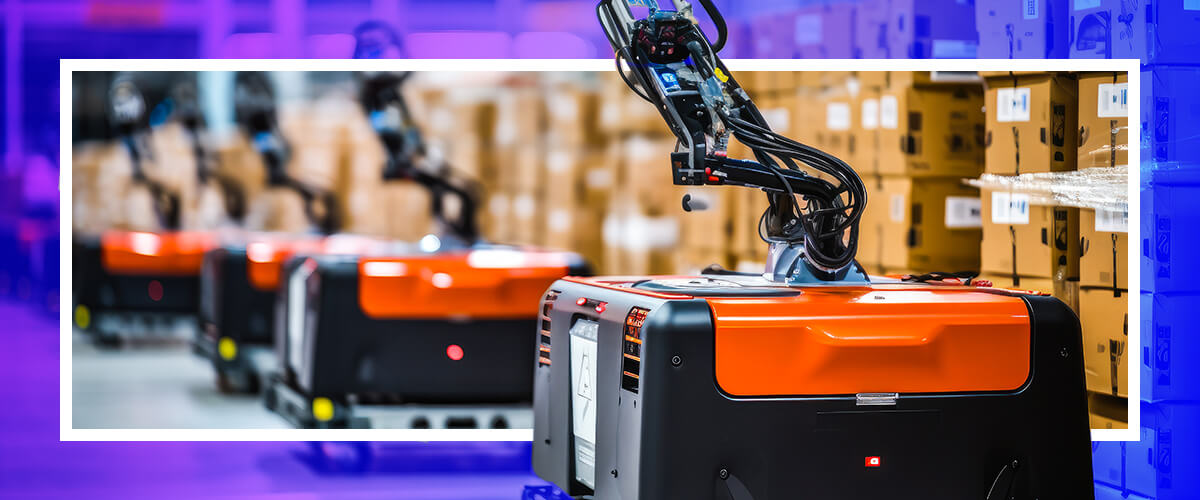In the fast-paced world of e-commerce and logistics, fulfillment centers are constantly seeking ways to improve efficiency and reduce costs. Central to these operations are Warehouse Management Systems (WMS), the software backbone that coordinates and optimizes warehouse activities. With picking operations accounting for a staggering 60-70% of labor costs, it’s no surprise that this area has become a focal point for innovation in WMS and beyond. Today, we’re witnessing a fascinating dichotomy in approaches to optimize this crucial process: the rise of robotics and the advancement of AI-driven optimization in warehouse management software.
Contents
The Robotics Revolution
Companies like Autostore are at the forefront of a robotics revolution, reimagining picking operations by eliminating manual processes entirely. These cutting-edge solutions promise to transform warehouses into highly automated environments where robots handle the bulk of picking tasks, often requiring significant updates or overhauls to existing warehouse management systems. The potential for increased speed, accuracy, and 24/7 operations is immense.
However, the path to robotic fulfillment isn’t without its challenges. Many fulfillment centers are still running on legacy Warehouse Management Systems (WMS) that predate some of their youngest employees. Integrating advanced robotics with these older WMS can be a complex and sometimes frustrating process, often requiring a complete replacement of the existing warehouse management software.
Interestingly, despite the complexity of the technology involved, implementing these robotic systems can often be accomplished more quickly than deploying or integrating traditional WMS solutions. This speed of implementation is a significant advantage in an industry where time is money, but it also highlights the need for more flexible and adaptable warehouse management systems.
The AI Optimization Approach
On the other side of the coin, companies like Logiwa are leveraging artificial intelligence to enhance existing picking processes and warehouse management software. Rather than replacing human workers with robots, this approach focuses on optimizing the performance of current systems and staff through intelligent WMS enhancements.
The results of AI-driven task optimization within modern warehouse management systems have been nothing short of remarkable. Logiwa’s AI solutions, for instance, have demonstrated the ability to reduce picking and packing costs by up to 58% in real-world applications over the past 18 months. This level of improvement can be game-changing for fulfillment centers, especially those that may not have the capital to invest in full robotic automation but can upgrade their WMS with AI capabilities.
An Unexpected Synergy
As the industry evolves, we’re seeing an interesting trend emerge. Modern robotics companies are increasingly partnering with next-generation WMS providers known for their rapid deployment capabilities and open API support. This collaboration is creating new opportunities for fulfillment centers to adopt advanced technologies more seamlessly, bridging the gap between traditional warehouse management software and cutting-edge robotics.
The Path Forward
This dual-track evolution in fulfillment technology and warehouse management systems raises several important questions for the industry:
- Will we see a divide between “high-tech” robotic warehouses with advanced WMS and AI-optimized traditional centers using enhanced warehouse management software?
- How will these technological advancements in WMS and robotics impact the workforce and the required skill sets in fulfillment?
- Could future AI advancements in warehouse management systems eventually bridge the gap, making advanced optimization accessible to all?
For fulfillment center operators, the message is clear: embracing technological innovation in warehouse management systems is no longer optional – it’s essential for staying competitive in today’s market. Whether through robotics integration or AI optimization of existing WMS, the future of fulfillment lies in leveraging technology to drive efficiency and reduce costs.
The Coexistence of Robotics and AI in Warehouse Management
While it may seem like an either/or choice between robotics and AI optimization in warehouse management software, the reality is that both approaches have their place in the future of fulfillment. Robotics can provide unparalleled efficiency for high-volume operations, while AI optimization offers a more accessible path to improvement for a broader range of fulfillment centers through enhanced WMS functionality.
As these technologies continue to evolve, we may even see increased convergence, with AI-driven warehouse management systems managing robotic operations to create even more efficient and adaptive fulfillment solutions.
In conclusion, the fulfillment industry stands at the cusp of a technological revolution in warehouse management. Whether you’re team robotics, team AI, or see a future where both coexist within advanced WMS platforms, one thing is certain: the fulfillment centers of tomorrow will be smarter, faster, and more efficient than ever before. The question is, how will you adapt your warehouse management system to stay ahead of the curve?
Schedule a call today, and our experts will walk you through how you can get the most out of the Logiwa IO fulfillment management system.
FAQs about robotics and AI optimization
What is a Warehouse Management System (WMS)?
How can robotics improve warehouse picking operations?
How does AI-driven optimization differ from robotic automation in warehouse management?
Can robotics and AI coexist within a warehouse management system?
Yes, robotics and AI can coexist and even complement each other in a warehouse management system. Robotics can handle repetitive tasks, while AI-driven WMS can optimize workflows and manage operations, creating a more adaptable and efficient fulfillment environment.





